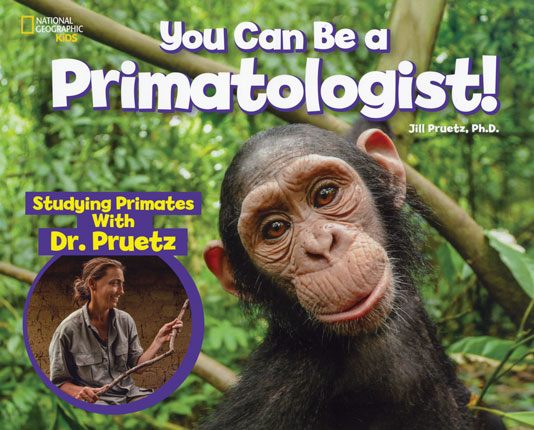| You can be a primatologist (You Can Be A ...) Author: Pruetz, J. D. | ||
| Price: $22.38 | ||
Summary:
Come along with Dr. Jill Pruetz as she heads to the wilds of Africa to study chimpanzees and other primates. Through simple, accessible text in question-and-answer format and bright photography, young scientists will learn all about this exciting science career.
Reviews:
Booklist (05/01/20)
Full Text Reviews:
School Library Journal - 04/01/2020 Gr 2–4—Being a primatologist is as difficult as it is rewarding. Dr. Jill Pruetz studies and observes the primates near the village of Fongoli in Senegal because relatively little is known about them or how they live their lives. Each day, the author and her team walk for miles and take notes as they make new observations about these fascinating animals. Through this research, primatologists hope that more actions will be taken to preserve the lives of primates around the world. Told in a mix of narrative and factual presentation, the book engages a wide range of readers. Varying font sizes and colors coupled with vivid, full-color photographs create visual appeal. The endpapers are filled with silhouettes of many different kinds of primates, setting the tone for the text within. The end of the book outlines what children can do if they are interested in becoming primatologists. From reading to natural observation, young readers have much at their disposal to learn about animals and enhance their observational skills. A glossary ensures comprehension of the new concepts introduced. VERDICT This worthy library addition serves to both educate and inspire young readers in the effort to preserve primates and their habitat well into the future.—Mary Lanni, formerly at Denver Public Library - Copyright 2020 Publishers Weekly, Library Journal and/or School Library Journal used with permission.
School Library Journal - 04/01/2020 Gr 2–4—Being a primatologist is as difficult as it is rewarding. Dr. Jill Pruetz studies and observes the primates near the village of Fongoli in Senegal because relatively little is known about them or how they live their lives. Each day, the author and her team walk for miles and take notes as they make new observations about these fascinating animals. Through this research, primatologists hope that more actions will be taken to preserve the lives of primates around the world. Told in a mix of narrative and factual presentation, the book engages a wide range of readers. Varying font sizes and colors coupled with vivid, full-color photographs create visual appeal. The endpapers are filled with silhouettes of many different kinds of primates, setting the tone for the text within. The end of the book outlines what children can do if they are interested in becoming primatologists. From reading to natural observation, young readers have much at their disposal to learn about animals and enhance their observational skills. A glossary ensures comprehension of the new concepts introduced. VERDICT This worthy library addition serves to both educate and inspire young readers in the effort to preserve primates and their habitat well into the future.—Mary Lanni, formerly at Denver Public Library - Copyright 2020 Publishers Weekly, Library Journal and/or School Library Journal used with permission.
Booklist - 05/01/2020 Primatologist Jill Pruetz introduces her work: the study of primates—specifically, the chimpanzees living near the village of Fongoli, Senegal. Their territory encompasses 40 square miles of savanna and woodland, which means plenty of walking for Pruetz and her team. Following the chimps at a little distance, the team observes the apes foraging for food, grooming each other, and even making spears for hunting. The scientist compares studying chimps in the wild to watching a movie and helps readers empathize by showing how people and chimps are alike. The text clearly and concisely answers a series of questions, such as “What do primatologists bring with them into the field?” “Do the chimps remember you?” and finally “How do I become a primatologist?” This wide-format book uses color effectively in the layout, in highlighting lines of text, and in the many excellent photos of chimps (and a few of Pruetz as well). This third book in the You Can Be a . . . series offers an engaging portrayal of chimps and a scientist who studies them. - Copyright 2020 Booklist.



